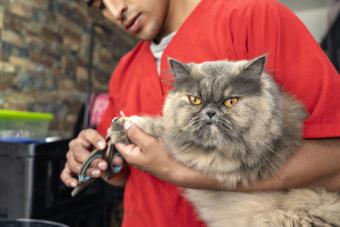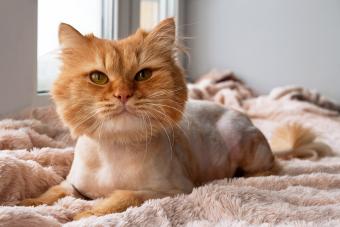
Cats are natural self-groomers, but sometimes you have to step in to help, especially if your kitty has a long-haired coat. Many pet parents don't groom their long-haired cats frequently enough, which can lead to matting. Long-haired cats need more coat care than short-haired cats, who can go weeks without receiving a good brushing. Don't worry. Grooming doesn't have to be a long process. You can usually maintain the best-looking coat and ensure your furry friend's happiness and health with just a few minutes per day.
Grooming Your Long-Haired Cat
Fur buildup happens more quickly than you might think. If this excess fur isn't dealt with, your long-haired cat can develop matted clumps of hair, tangled dreadlocks that can twist and cause discomfort, and leftover dead skin cells.
Long-haired cats may have more problems with hairballs than short-haired breeds, so controlling their coat can help keep them from coughing up these disgusting tangles of fur or developing more serious complications.
1. Make Grooming Routine
If you start young with your kitty and make brushing and regular grooming a part of their regular schedule, grooming your cat as an adult will be much easier. Over time, your cat will probably not only look forward to a gentle brushing but might even start to insist on grooming time!
Make sure you go slow, especially if your cat isn't used to being groomed. Be gentle, make the experience positive, and even offer treats to keep your kitty interested.
2. Start With a Wide-Tooth Comb
This tool is especially useful for long-haired cats. Wide-toothed combs help remove loose, dead hair and smooth out any tangles or mats in cat fur. Combs with offset tines are especially good for detangling work.
Technique tip: Comb downward with the lay of the fur, moving from head to tail. This will help protect your cat's sensitive skin from irritation caused by pulling on mats or tangles while removing debris. Start in sections, and move down from your cat's neck to their back and sides in short, gentle, slow strokes.
3. Many Long Hair Cats Have an Undercoat
If they have an undercoat, which most long-haired cats do, you'll want to use either a slicker brush or pin brush so that you can get through their thick hair without pulling any out by accident. If they don't have an undercoat, any regular brush will do just fine.
Technique tip: Start with straight strokes, and if their undercoat isn't catching, try using small circular motions as you move toward their tail end. Although it might be tempting to work against the fur grain to try to get at your cat's undercoat, don't do it. Brushing against the fur can actually cause matting and hair breakage.
4. Detangle as You Go
When you feel your brush hit a snag, don't try to pull it out. Instead, brush it out gently. In some cases, you might try a little baby powder and a mat breaker tool to help detangle stubborn clumps. Just put some of the talc powder on the mat and work it in lightly with a gentle massage. If this doesn't work, you might have to move on and leave the clump for now.
Technique tip: Try to tease out the mat a bit with your fingers and work it apart with the mat breaker. Stop immediately if your cat shows any sensitivity. Make sure the hair clump isn't putting pressure on your cat's skin, and do not pull on the clump.
5. Follow Up With a Fine-Tooth Comb
Once you have removed any mats in your cat's fur, use a fine-tooth comb to promote coat and skin health. This will carry away any remaining dead fur and help distribute your cat's natural oils through their fur.
Technique tip: Take a break between de-matting your cat's coat and finishing up with a fine-tooth comb if they're acting anxious or irritated. Go slow and use this step as a way to check their coat for any remaining hidden clumps or mats.
6. Grab the Grooming Glove
Using a grooming glove is a great way to finish off your cat's grooming process. Grooming gloves can further improve your cat's skin and coat. They also help you gently massage your cat's skin and stimulate blood flow, helping them relax.
Technique tip: This step is mostly to help your cat relax and finish picking up any remaining loose hairs. Basically, just gently pet your cat and let them enjoy the attention.
7. See a Professional for Stubborn Mats
If you find yourself dealing with stubborn mats that won’t budge, it’s time to see a professional. Shaving your cat at home isn’t safe because cat skin isn’t like human or even dog skin. It’s incredibly delicate and can easily nick or tear without any rhyme or reason. It’s not worth the risk and can lead to painful wounds and even surgery to repair the skin.
Technique tip: Instead of attempting this yourself at home, have it done by a professional. Schedule an appointment with your groomer or veterinarian. Some facilities will let you hold your cat while they shave them to keep them comfortable and calm.
Never use scissors to remove matted hair from your cat's coat. If your cat gets scared or you accidentally pull too hard and they try to get away, sharp scissors might cut or injure your cat.
Additional Grooming Tricks for Long Hair Cats
Brushing your cat's fur isn't the only part of grooming. Regular maintenance is important, and if you keep up with your cat's grooming needs, they won't need as much intensive brushing and clipping later.
How Often Should You Groom Your Long-Haired Cat?
Ideally, performing a light daily brushing on your long-haired cat is the best way to prevent mats from forming. However, your cat may not tolerate this much attention, and weekly grooming sessions just focusing on brushing can do a lot to control matting. For more intensive de-matting sessions, every two weeks to once a month should be sufficient if you're keeping up with regular brushing.
Make Trimming Your Cat's Claws a Habit
Your cat's claws need regular attention, too. Clipping their claws can be a challenge, so make sure you know how to do it right. Ideally, you should check and trim their claws every two weeks or so, but once a month should suffice.
Related: How to Trim Your Cat's Claws
Do You Need to Bathe Your Long-Haired Cat?
There is no need to bathe your long-haired cat unless they get really dirty, get into something they shouldn't, or start to smell bad. Long-haired cats are self-grooming and can be quite particular about their appearance. However, cats that are allowed outside may get especially messy from time to time, or they might pick up parasites like ticks and fleas. If you're brushing your long-haired fur baby often, you shouldn't need to lather them up very often, if at all.
Related: How to Brush Your Cat's Teeth
Don't Avoid Your Groomer
Sometimes, your long-haired cat's coat just needs the extra attention of a professional groomer. Many cats hate going to the groomer, so you might find yourself putting this off to keep from stressing them out. However, you have options. In many areas, mobile groomers who specialize in cats can come directly to you and help deal with serious matting issues.
Related: 8 Clues Your Cat Is Stressing Out & How to Calm Them Down
Tools for Grooming Long-Haired Cats
If you have a long-haired cat or multiple long-haired cats, it's important to have all the tools you need on hand. This way, you don't have to make a special trip any time your cat needs brushed or must have mats removed from their fur. The following are the recommended tools to have at your disposal:
Wide-Tooth Comb
This type of comb has wider teeth than most cat brushes, which makes it better for removing tangles and mats from fur.
Fine-Tooth Comb
Long-haired cats need combs with very fine teeth that will catch even the smallest tangles without causing discomfort to either party involved.
Soft-Bristled Brush
A brush with soft bristles helps remove loose hairs and dirt from the undercoat of your cat's fur without causing discomfort or damage to the outer coat layer, the guard hair.
Slicker Brush
A slicker brush with stiff wire bristles helps remove loose hair and mats.
De-matting Tool
A mat splitter or mat remover has teeth that separate hairs or cut mats out without pulling on them.
Grooming Glove
The best grooming glove should be comfortable and easy to clean. It should also have a good grip so that you can use it on many types of fur.
Keep Your Long-Haired Kitty in Top Shape
If you're new to grooming your cat, start slowly when you first begin. Your cat may not be used to being brushed or handled regularly and may react negatively, even trying to bite or scratch you. It's all about being gentle and going at your cat's pace. Once you've established a routine with your cat, however, brushing should become second nature for both of you.







